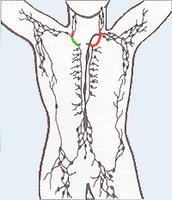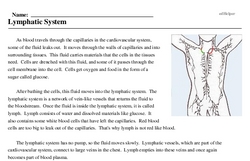Lymphatic System
As blood travels through the capillaries in the cardiovascular system, some of the fluid leaks out. It moves through the walls of capillaries and into surrounding tissues. This fluid carries materials that the cells in the tissues need. Cells are drenched with this fluid, and some of it passes through the cell membrane into the cell. Cells get oxygen and food in the form of a sugar called glucose.
After bathing the cells, this fluid moves into the lymphatic system. The lymphatic system is a network of vein-like vessels that returns the fluid to the bloodstream. Once the fluid is inside the lymphatic system, it is called lymph. Lymph consists of water and dissolved materials like glucose. It also contains some white blood cells that have left the capillaries. Red blood cells are too big to leak out of the capillaries. That's why lymph is not red like blood.
The lymphatic system has no pump, so the fluid moves slowly. Lymphatic vessels, which are part of the cardiovascular system, connect to large veins in the chest. Lymph empties into these veins and once again becomes part of blood plasma.




